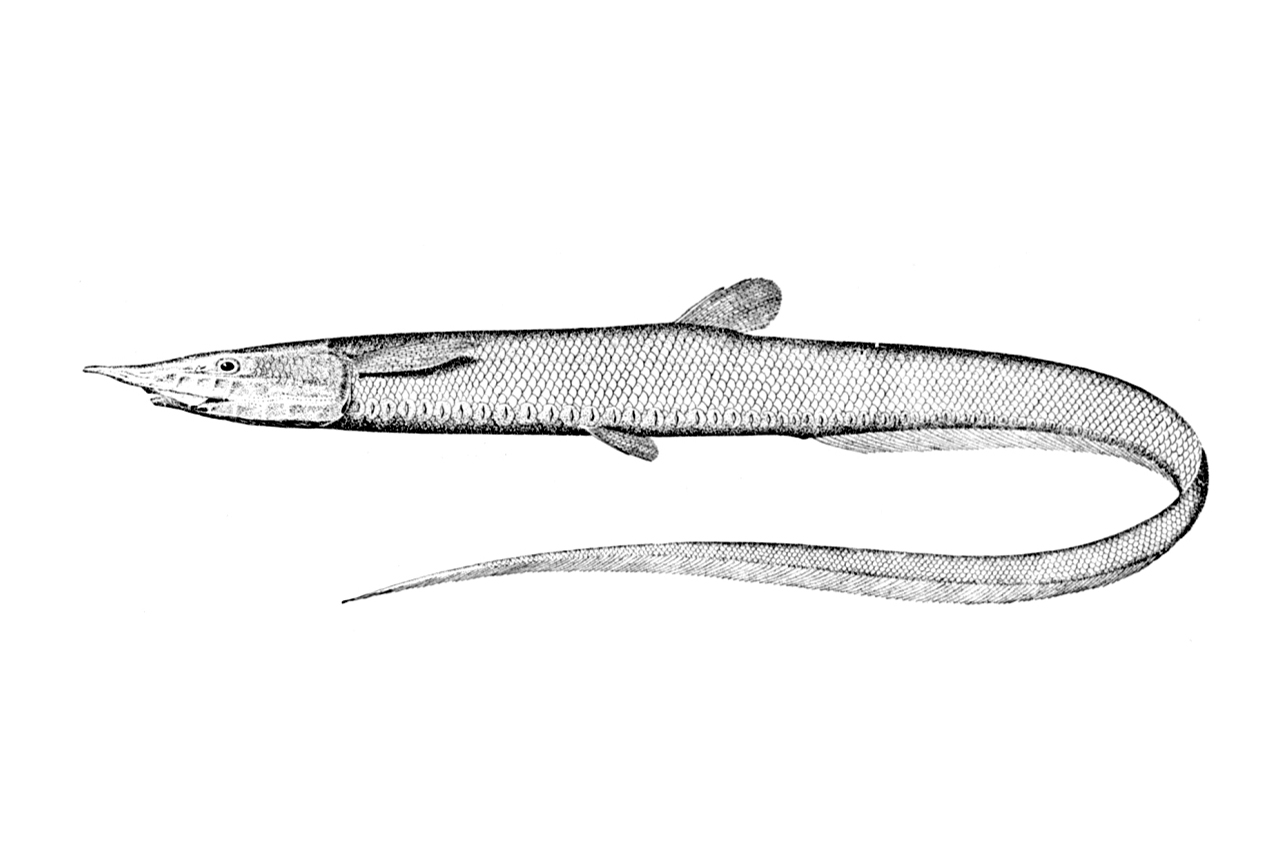Sharpnose Halosaur, Aldrovandia rostrata (Günther 1878)
Other Names: Longnose Halosaur

Illustration of a Sharpnose Halosaur, Aldrovandia rostrata. Source: Goode & Bean (1896) / Wikimedia Commons. License: CC by Attribution-NonCommercial-ShareAlike
Summary:
A pale brown to silvery halosaur with a long, sharp snout, the lower part of the head and the gill cover black, a black abdominal region, a black anus surrounded by a white ring, and a dark mouth lining. The pelvic fins are inserted well before the dorsal-fin origin.
Cite this page as:
Bray, D.J. 2022, Aldrovandia rostrata in Fishes of Australia, accessed 27 Jun 2025, https://fishesofaustralia.net.au/home/species/5684
Sharpnose Halosaur, Aldrovandia rostrata (Günther 1878)
More Info
|
Distribution |
Off Christmas Island, eastern Indian Ocean, depth 3200-3345 m. Elsewhere the species occurs in the Atlantic Ocean. Inhabits the abyssal plain over soft bottom areas. |
|
Features |
Dorsal fin 11; Pectoral fin I,11 Pelvic fin I,9; Gill rakers 14 (total first arch); Lateral line 22-23 (before anus), one lateral-line scale to every 2 body scales; Pyloric caecae 7. Body very elongate, moderately compressed; mouth small (width of premaxilla three times in snout length); snout long, pointed. Preoral portion of snout very long, less than 2 times in total snout length. Scales absent on top of head and opercle. Lateral line scales two times larger than body scales, continuous with each other.Dorsal fin origin posterior to pelvic fin origin; first dorsal ray very short, vestigial. |
|
Etymology |
The specific name is from the Latin rostratus (= beaked), in reference to the “very much produced” snout of this species. |
|
Species Citation |
Halosaurus rostratus Günther 1878, Annals and Magazine of Natural History (5)2(7/8/9)(2/22/28): 251. Type locality: Mid-Atlantic, 35°29'N, 50°53'W, Challenger station 63, depth 2750 fathoms. |
|
Author |
Bray, D.J. 2022 |
|
Resources |
Catalog of Fishes |
Sharpnose Halosaur, Aldrovandia rostrata (Günther 1878)
References
Cohen, D.M. (ed.) 1973. Fishes of the western North Atlantic. Halosuriforms, Killfishes, Squirrelfishes and other Beryciforms, Stephanoberyciforms, Grenadiers. Yale University : The Sears Foundation of Marine Research Mem. I Pt 6 698 pp. https://doi.org/10.12987/9781933789293
Günther, A. 1878. Preliminary notices of deep-sea fishes collected during the voyage of H.M.S. Challenger. Annals and Magazine of Natural History 5 2(2, 22, 28): 17-28, 179-187, 248-251 See ref at BHL
Günther, A. 1887. Report on the deep-sea fishes collected by H.M.S Challenger during the years 1873–1876. Report on the Scientific Results of the Voyage of H.M.S. Challenger 1873–1876, Zoology 22(57): 1-268 figs 1-7 pls 1-66 See ref at BHL
Haedrich, R.L. & Merrett, N.R. 1988. Summary atlas of deep-living demersal fishes in the North Atlantic Basin. Journal of Natural History 22: 1325-1362.
McDowell, S.B. (1973) in Cohen, D.M., Marshall, N.B., Ebeling, A.W., Rosen, D.E., et al. 1973. Fishes of the Western North Atlantic. Part 6. Hereromi, Cyprinodontoidei, Berycomorphi, Xenoberyces, Anacanthini. Memoir No. 1. Sears Foundation for Marine Research; Yale University, New Haven, CT. 698 pp., 235 plates. See ref at BHL
Smith, D.G. 2016. Halosauridae, Halosaurs pp. 1594-1600 in Carpenter, K.E. & De Angelis, N. (eds). The living marine resources of the Eastern Central Atlantic. Volume 3. Bony fishes part 1 (Elopiformes to Scorpaeniformes). FAO Species Identification Guide for Fishery Purposes. Rome, FAO. i-xiv + 1511-2350.
Sulak, K.J. 1990. Halosauridae. pp. 126-132 in Quéro, J.-C., Hureau, J.-C., Karrer, C., Post, A. & Saldanha, L. (eds). Check-list of the Fishes of the Eastern Tropical Atlantic. Paris : UNESCO 1492 pp., 3 vols.
Tighe, K. 2015. Aldrovandia rostrata. The IUCN Red List of Threatened Species 2015: e.T195839A2425844. https://dx.doi.org/10.2305/IUCN.UK.2015-4.RLTS.T195839A2425844.en. Accessed on 23 August 2022.


